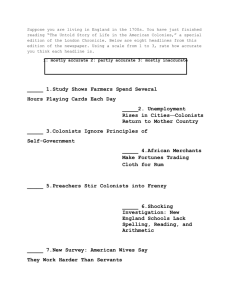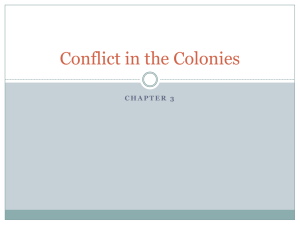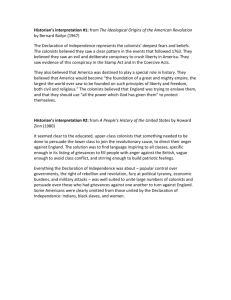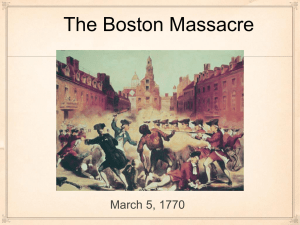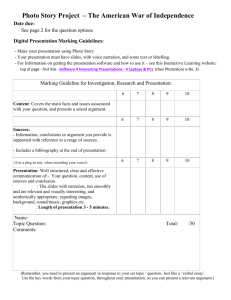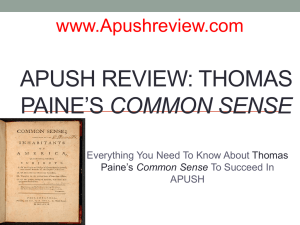Social Studies 11-12 Stereotypes of Native Americans
advertisement
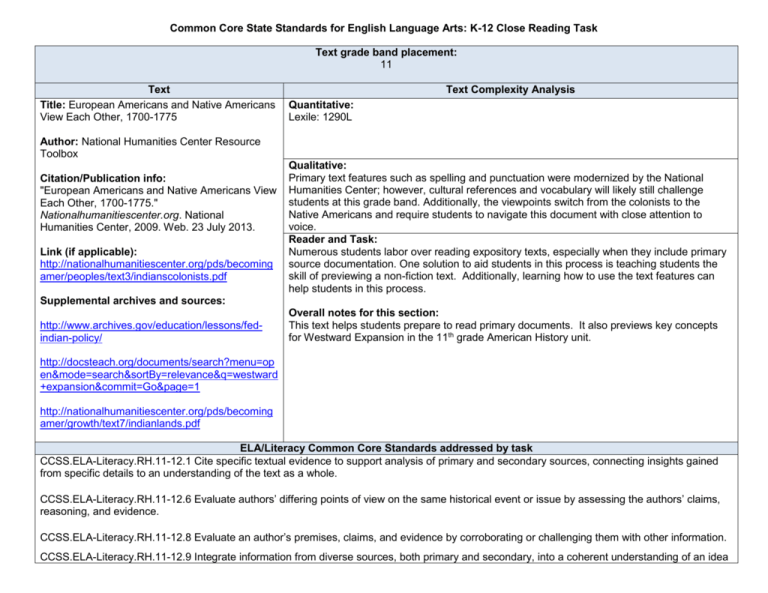
Common Core State Standards for English Language Arts: K-12 Close Reading Task Text grade band placement: 11 Text Title: European Americans and Native Americans View Each Other, 1700-1775 Text Complexity Analysis Quantitative: Lexile: 1290L Author: National Humanities Center Resource Toolbox Citation/Publication info: "European Americans and Native Americans View Each Other, 1700-1775." Nationalhumanitiescenter.org. National Humanities Center, 2009. Web. 23 July 2013. Link (if applicable): http://nationalhumanitiescenter.org/pds/becoming amer/peoples/text3/indianscolonists.pdf Qualitative: Primary text features such as spelling and punctuation were modernized by the National Humanities Center; however, cultural references and vocabulary will likely still challenge students at this grade band. Additionally, the viewpoints switch from the colonists to the Native Americans and require students to navigate this document with close attention to voice. Reader and Task: Numerous students labor over reading expository texts, especially when they include primary source documentation. One solution to aid students in this process is teaching students the skill of previewing a non-fiction text. Additionally, learning how to use the text features can help students in this process. Supplemental archives and sources: http://www.archives.gov/education/lessons/fedindian-policy/ Overall notes for this section: This text helps students prepare to read primary documents. It also previews key concepts for Westward Expansion in the 11th grade American History unit. http://docsteach.org/documents/search?menu=op en&mode=search&sortBy=relevance&q=westward +expansion&commit=Go&page=1 http://nationalhumanitiescenter.org/pds/becoming amer/growth/text7/indianlands.pdf ELA/Literacy Common Core Standards addressed by task CCSS.ELA-Literacy.RH.11-12.1 Cite specific textual evidence to support analysis of primary and secondary sources, connecting insights gained from specific details to an understanding of the text as a whole. CCSS.ELA-Literacy.RH.11-12.6 Evaluate authors’ differing points of view on the same historical event or issue by assessing the authors’ claims, reasoning, and evidence. CCSS.ELA-Literacy.RH.11-12.8 Evaluate an author’s premises, claims, and evidence by corroborating or challenging them with other information. CCSS.ELA-Literacy.RH.11-12.9 Integrate information from diverse sources, both primary and secondary, into a coherent understanding of an idea or event, noting discrepancies among sources CCSS.ELA-Literacy.WHST.11-12.2 Write informative/explanatory texts, including the narration of historical events, scientific procedures/ experiments, or technical processes. What key insights should students take from this text? Students should be able to note differing perspectives that were recorded of Native Americans. Students should be able to explain how negative perspectives influenced stereotypes of Native Americans. Students should be able to relate how stereotypes of the Native Americans affected future decisions in Westward Expansion in America when this text is paired with primary documents such as The Dawes Act and its subsequent amendments. Text-Dependent Questions Find an excerpt from the text that tells you about life in America for both the colonists and the Native Americans during this time. What evidence is provided to point to the relationship between the colonists and the Native Americans? What viewpoints do different colonists present upon meeting Native Americans? What viewpoints do Native Americans present upon meeting the colonists? Delineate between the positive and negative perspectives the colonists and the Native Americans expressed of each other. What evidence from the text supports positive perspectives of the Native Americans? Negative? When and how do colonists praise the Indians, and vice versa? Cite evidence for when you think the praise is sincere, or when it is expressed for diplomatic or manipulative purposes. Writing Mode Informative/explanatory Writing Prompt Explain the perceptions early American colonists expressed toward Native Americans and how these beliefs impacted life for the Native Americans. Cite specific examples from at least six of the texts. Use appropriate conventions of standard written English. [Note: If paired with additional readings concerning the topic of Westward Expansion in America, students could write an argumentative essay either supporting the colonists’ claims to the land or defending the varying Native American perspectives regarding land ownership.] Scaffolding and support for special education students, English language learners, and struggling readers: The skill of previewing and understanding basic text features could benefit students who have not had much exposure to primary documents; however, the teacher will need to be careful to do so briefly without giving away too much content as well as isolating/disengaging students at the beginning of the lesson. Multiple in-class discussions of the text-dependent questions will also likely help all students. The teacher could scaffold learning by creating a t-chart with one side stating Settlers’ Beliefs and the other side stating Native American Beliefs. How this task supports the content standards for relevant subject area courses in this grade band Prior to teaching concepts of Westward expansion and its effect on Native American culture, this text would help students to trace the development of perspectives and stereotypes of Native Americans. This task would support the content area standards for a US history course because a close reading of primary accounts from early colonists and Native Americans would help students understand the decisions made in the push for American expansion and its subsequent effect on Native Americans.
